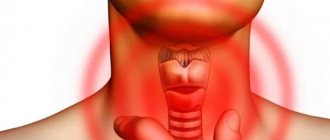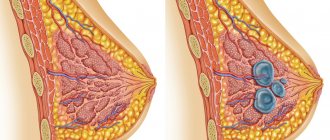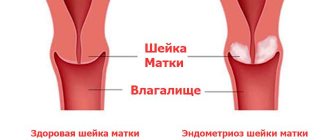Issues discussed in the material:
- What changes occur in the body of older women
- What diseases mainly bother older women?
- What methods are used to treat diseases of elderly women?
- What are the basic rules of a healthy lifestyle for older women?
As you know, as we age, we become increasingly concerned about health problems. When a woman turns 50 years old, she may develop diseases that previously did not indicate themselves in any way. Some put up with what is happening, considering it inevitable, while others try to find ways to prolong their beauty and maintain health. What diseases of older women exist, how are they diagnosed and treated?
Changes in the female body after 50
At the age of 50, most female representatives enter menopause (last menstruation), followed by postmenopause and aging of the body. At this time, the ovaries produce less and less female sex hormones estrogen and progesterone. Hormonal changes negatively affect the condition of organs and systems, since sex hormones regulated the functions of the entire body. At this age, for many, the vegetative manifestations of menopause (hot flashes, increased sweating, attacks of increased heart rate, changes in blood pressure - blood pressure, irritability and anxiety) decline, and symptoms associated with changes in metabolism come first. Women's health after 55 years of age reflects these trends even more:
- immunity decreases, acute and chronic infectious processes (sinusitis, bronchitis, cystitis, etc.) develop more often;
- age-related disorders of carbohydrate metabolism can manifest themselves in the form of type 2 diabetes mellitus - a condition when tissues cannot fully absorb glucose and it accumulates in the blood; with diabetes mellitus, immunity is further reduced, the woman becomes defenseless against infections; the functioning of peripheral nerves and small blood vessels is disrupted, which can lead to the appearance of trophic ulcers and diabetic foot - conditions that can result in gangrene of the extremities;
- estrogen deficiency leads to loss of calcium in the bones - calcium enters the blood, its content exceeds the norm (hypercalcemia); bones become thinner, there is a risk of fractures; hypercalcemia contributes to the appearance of convulsive readiness, cardiac arrhythmia and depression;
- age-related changes in fat metabolism and a sedentary lifestyle contribute to the development of obesity; this negatively affects the condition of the circulatory system, spine and joints; but it is impossible to completely get rid of fat, since fat cells (adipocytes) produce sex hormones;
- due to disorders of cholesterol metabolism, the phenomena of atherosclerosis are increasing, and with it the number of diseases of the heart and blood vessels such as angina pectoris, myocardial infarction, ischemic stroke, etc.; after changes in blood pressure characteristic of premenopause, many women develop persistently elevated blood pressure - arterial hypertension;
- blood circulation in the veins is disrupted, especially with excess weight and a sedentary lifestyle; venous valves blocking the reverse flow of blood in the veins of the lower extremities do not work, venous branches appear on the skin of the legs;
- due to age-related changes in metabolism, degenerative-dystrophic disorders in bone tissue intensify - osteochondrosis and osteoarthritis develop, accompanied by pain and movement disorders;
- lack of estrogen leads to dry mucous membranes, including the genitourinary organs; lack of progesterone can manifest itself in the form of heavy menstrual and intermenstrual (acyclic) bleeding;
- hormonal imbalance contributes to the development of cancer; but hormone replacement therapy (HRT) only increases the risk of developing malignant tumors of the female genital area.
Musculoskeletal system
Osteoporosis is a serious problem of our time; by the age of 50, every second woman in the world suffers from this disease.
It is characterized by a decrease in bone mass. Bones become excessively fragile, and the risk of fractures and injuries increases.
Additional risk factors include:
- onset of menopause
- chronic endocrine diseases
- diseases of the digestive, genitourinary, circulatory systems
- smoking
- physical inactivity
- calcium deficiency
- alcohol abuse
- dystrophy
In addition, osteochondrosis of various parts of the spine, radiculitis, and neuritis are worsening.
What examinations should be taken after 50 years of age?
Of particular importance in how a woman can maintain her health after 50 years is the timely detection of diseases. A large number of problems require thorough examination and identification of diseases at an early stage. To keep the body healthy, annual medical examinations should be performed. Recommended mandatory clinical minimum of examinations after 50 years:
Examination by specialists
- therapist: identifies possible diseases of internal organs, if necessary, sends for consultation with specialists and for additional studies; he also makes a conclusion based on the results of a complete examination of the woman’s condition;
- neurologist: identifies diseases of the peripheral (radiculitis against the background of osteochondrosis, neuritis, etc.) and central (cerebrovascular accidents) nervous system;
- surgeon (who can also be a mammologist): identifies varicose veins, hemorrhoids, breast tumors, mastopathy;
- ophthalmologist: measures intraocular pressure, examines the vessels of the fundus (their condition corresponds to the condition of the arteries and veins of the brain);
- endocrinologist: checks the condition of the thyroid gland, excludes diabetes mellitus; if some other pathology is suspected, an additional examination is prescribed;
- gynecologist - annual examination in a chair, exclusion of inflammatory and oncological processes.
Additional examination
- general blood test: will reveal the presence of anemia, allergies, inflammatory processes of bacterial origin, viral infections;
- biochemical blood test: will reveal diseases of the kidneys, liver, pancreas (including diabetes), disorders of cholesterol metabolism, blood clotting, imbalance of the main blood electrolytes (potassium, magnesium, calcium), necessary for the functioning of the heart muscle (myocardium);
- general urine test: will reveal pathology of the kidneys and urinary tract;
- ECG (electrocardiography): determines how well the heart is working; detects tachycardia, bradycardia, arrhythmia, hypertrophy (thickening) of the myocardial walls, indicating increased blood pressure; is a screening that allows you to select patients for cardiac check-up;
- Chest fluorography: an annual examination reveals lung diseases (tuberculosis, etc.), as well as an increase in the size of the heart.
Oncological checkup (check up)
Complete express examination of persons suspected of cancer. It is carried out with the aim of identifying cancer pathology at an early stage. Oncological check-up is especially relevant after fifty-five, it includes:
- all mandatory laboratory tests + blood test for hormones + test for cancer markers + stool test for occult blood + cytological examination of a smear taken from the cervical canal;
- instrumental studies: ultrasound of the thyroid gland, soft tissues and vessels of the neck, abdominal cavity and pelvis, mammography (X-ray examination of the breast), CT or MRI of internal organs and other tissues;
- if necessary, endoscopic examinations (bronchoscopy, gastroscopy, colonoscopy, rectoscopy, colposcopy) are prescribed: it is also possible to take a piece of tissue (biopsy) for analysis;
- consultation with an oncologist specializing in the treatment of identified cancer diseases; Based on the results of the examination, the oncologist either confirms the absence of a tumor, or (if a tumor is detected) makes recommendations for treatment.
Cardiological checkup
It is carried out if a woman has heart complaints or changes in the ECG. Cardiological checkup includes:
- testing - a woman fills out a questionnaire specially designed for these purposes; this allows us to identify complaints from the cardiovascular system, heredity, bad habits, etc.;
- all mandatory laboratory tests + study of the protein composition of the blood (detection of proteins specific to heart diseases and markers of the risk of cardiac pathology);
- ECG at rest and with various loads;
- 24-hour ECG monitoring is a study that is carried out throughout the day and allows you to more accurately identify disorders;
- echocardiography - ultrasound of the heart;
- daily blood pressure study;
- Ultrasound of the thyroid gland and neck vessels;
- MRI of the heart (if necessary).
What determines the severity of menopause?
The severity of symptoms is influenced by the following factors:
- general health, presence of diseases of the ovaries and uterus, endocrine disorders;
- number of pregnancies, births, abortions, operations on the uterus and ovaries;
- presence or absence of sexual activity, sexual activity;
- state of immunity, physical fitness;
- lifestyle, presence or absence of bad habits.
Video: Signs of menopause, why pathologies develop, which of them are especially dangerous
Indicators requiring monitoring
There are a number of laboratory indicators that reflect metabolic disorders that appear in the female body after 50 years. Expert advice: monitor these indicators so that you can notice changes in time, at an early stage, and prevent the progression of serious diseases:
Hemoglobin (Hb)
A complex iron-containing protein in red blood cells (erythrocytes) that carries oxygen from the lungs to tissues and organs throughout the body. The normal hemoglobin parameters for women 50 years old are 110 – 150 g/l (small fluctuations are acceptable). With a lack of hemoglobin, iron deficiency anemia develops and the entire body suffers. The brain suffers especially hard from oxygen deficiency.
In women with anemia, this is manifested by frequent fainting, impaired coordination of movements, memory and the ability to perceive new material. Most often, anemia at this age develops due to acyclic bleeding due to a lack of the female sex hormone progesterone. Poor nutrition, lack of animal food, and all kinds of extreme diets also have an effect.
Elevated Hb indicates a risk of developing thrombosis. With such disorders, it is better to immediately contact a specialist to prescribe treatment.
Cholesterol
Organic substance from the group of sterols (belong to steroids). This indicator requires constant monitoring, as it takes an active part in metabolic processes. The normal parameters for women over 50 years old are 4.2 -7.7 mmol/l (small fluctuations are acceptable). When there is an excess of cholesterol and its metabolism is disrupted, it is deposited on the walls of blood vessels, narrowing their lumen and disrupting the nutrition of organs.
If this occurs in the vessels that supply the heart muscle (coronary), then coronary heart disease develops with attacks of angina pectoris and the risk of developing myocardial infarction. With atherosclerosis of cerebral vessels, the risk of developing ischemic stroke increases.
Impaired cholesterol metabolism increases with diabetes mellitus, decreased thyroid function (hypothyroidism), gout, obesity, arterial hypertension, liver disease and some other conditions.
Low cholesterol levels in the blood are typical for infectious diseases, acute and chronic intestinal diseases, increased thyroid function (hyperthyroidism), etc.
Blood sugar
The normal blood levels are 3.3 and 5.5 mmol/l. You need to monitor your blood sugar, since it is at the age of 50 years and older that the risk of developing type 2 diabetes mellitus increases. The first signs of diabetes are extreme thirst and excessive urination.
Bilirubin (Br)
The pigment formed during the breakdown of hemoglobin is found in the blood in bound and free forms. The norm is 8.5 -20.5 µmol/l (small fluctuations are acceptable). Increased Br appears with hemolytic (with the breakdown of red blood cells) anemia and liver dysfunction. Signs of jaundice appear: the sclera of the eyes and skin become yellow, the urine becomes dark, foamy, and the feces are colorless. Jaundice is dangerous for the body, especially for the brain, so you should consult a doctor immediately.
Thyroid
By the age of half a century, the thyroid gland wears out, a woman can observe signs of dysfunction:
- sudden weight gain and loss without changing diet;
- unmotivated mood swings;
- muscle weakness;
- chills;
- headache;
- changing taste priorities;
- swelling of the face;
- hearing loss;
- hoarseness of voice;
- hypertension;
- weakness, drowsiness, absent-mindedness, forgetfulness;
- dry skin
An endocrinologist will be able to assess the condition of the thyroid gland by prescribing tests for thyroid hormones and TSH, the hormone that coordinates its work.
Lack of iodine from childhood can cause serious problems in old age.
Maintaining good health
To maintain the normal functioning of the female body, you need to know how this is done. Let’s take a look at how to improve a woman’s health after 50 years. Expert advice:
Get rid of iron deficiency anemia
Recommendations:
- contact a gynecologist and eliminate the bleeding;
- a slight decrease in hemoglobin can be eliminated through proper nutrition: you need to eat more meat, eggs, fish roe - animal food containing iron, which is well absorbed by the body; to improve metabolism you need to eat more vegetables and fruits;
- if there is a significant decrease in hemoglobin, the doctor prescribes medications containing iron and vitamin C (with it, iron is better absorbed better).
Heart and cardiovascular system
The threat of developing angina and myocardial infarction due to impaired cholesterol metabolism at this age is high. Expert advice: a healthy diet will help you maintain your health: fatty and fried foods and sweets should be excluded from your diet. Eat more vegetables and fruits - sources of vitamins.
There is a high risk of developing arterial hypertension. To reduce this risk, you need to remove salty foods from your diet, avoid stress and heavy mental stress, start leading an active lifestyle, move more, regulate sleep with the help of sedative herbal remedies (infusions of valerian, motherwort, etc.).
Genitourinary system
At this age, against the background of impaired metabolism, dry mucous membranes appear, including the urinary tract and genital organs. This manifests itself in the form of frequent urination and sometimes urinary incontinence. Sexual desire decreases, and dry vaginal mucosa makes sexual intercourse painful.
Activating metabolism through proper nutrition, taking vitamin and mineral complexes and a healthy active lifestyle will help eliminate dryness and maintain the normal condition of mucous membranes. If this does not help, you need to undergo a gynecological examination and individually selected treatment to maintain health: hormone replacement therapy, phytoestrogens or local treatment in the form of vaginal suppositories and creams with hormones (Ovestin cream and suppositories, etc.).
Thyroid
The function of the thyroid gland gradually decreases and there is a threat of developing hypothyroidism. This manifests itself in the appearance of excess weight, swelling, constant lethargy and fatigue. Hypothyroidism is especially dangerous because it gradually leads to dementia, so you need to contact an endocrinologist to prescribe treatment. Medicines containing thyroid hormones (Eutirox, etc.) will help.
Sometimes, after 50 years, increased function of the thyroid gland (hyperthyroidism) develops, its symptoms: weight loss, increased blood pressure, palpitations, anxiety, irritability. This condition is dangerous due to complications from the cardiovascular system, so you cannot hesitate, you must immediately contact an endocrinologist to prescribe treatment.
Musculoskeletal system
Osteoporosis and degenerative-dystrophic changes in the spine and joints lead to a tendency to fractures, osteochondrosis and osteoarthrosis develop - diseases associated with changes in cartilage tissue. Useful advice from a specialist: to treat osteoporosis, you should take calcium supplements (Calcium D3 Nycomed, etc.); for osteochondrosis and osteoarthritis, a balanced diet and a properly organized daily routine, combining light physical activity and rest, will help. It is necessary to strengthen the muscles that support the spine and joints, for this purpose therapeutic exercises are performed. Medicines containing glucosamine and chondroitin (Dona, Honda, Teraflex, etc.) are prescribed for the restoration of cartilage tissue. For severe pain in the joints and spine, medications from the group of non-steroidal anti-inflammatory drugs (NSAIDs - Diclofenac, Ibuprofen, Nimesulide, etc.) are prescribed.
beauty and health
Beauty and health are interconnected concepts. A healthy woman who, even after 50 years, constantly takes care of herself, may be even more attractive than in her youth. Rejuvenating treatments for the skin of the face and body in a beauty salon, combined with home care, a healthy lifestyle, proper rest and proper nutrition, can work wonders. In order to preserve and maintain beauty, cosmetologists recommend taking daily care of your face: cleansing, moisturizing and nourishing it with creams and masks at home. Periodically, it is worth visiting a beauty salon and performing rejuvenating hardware and injection procedures, facial and body massage.
Sports and physical activity
Light sports activities are something you can’t do without after 50 years. It's never too late to start, even if you previously led a sedentary lifestyle. At this time, a decrease in the intensity of metabolic processes contributes to excess weight gain, and this is dangerous for health, as it creates extra stress on the heart and musculoskeletal system. Therefore, light sports or at least daily gymnastics in combination with walking are mandatory. Light physical and even sports activities will bring back youth.
Proper nutrition
Due to the fact that metabolism slows down, the female body requires fewer calories to maintain it. Therefore, the daily diet after 50 should be reduced. It should contain more vegetables, fruits, fish, lean meat, and dairy products. If you don't do this, the extra calories will be stored as fat. But losing too much weight is not recommended, since fat cells produce estrogens. What to do? First of all, give up any extreme diets and take the principles of healthy, wholesome nutrition as a basis. Calorie intake depends on weight and activity. On average, it is equal to from 1800 to 2200 kcal per day. In more detail, the number of calories per day can be determined by the formula: K x weight, where K is the number of calories per 1 kg of weight. With low metabolism K = 31.
Sleeping mode
Don't forget about getting a good night's sleep. It should last exactly as long as necessary for proper rest. On average, this is 8 hours, but for one representative of the fair sex 7 hours is enough, while another should sleep at least 9.
Psychological health
Often after 50, a woman begins a new life: her children are grown, she has the opportunity to take care of herself. The psychological attitude is of great importance. If a woman is constantly in a good mood, feels healthy, beautiful and desirable, then those around her see her that way.
After 50 years, life does not end, but only begins. The quality of life at this age largely depends on the woman herself. She should start eating right, moving as much as possible, playing sports if possible, not forgetting about sleep, taking care of her appearance and remembering that she is the most charming and attractive.











